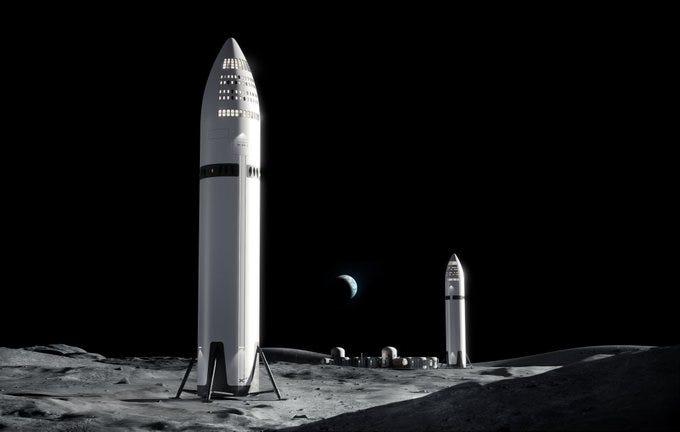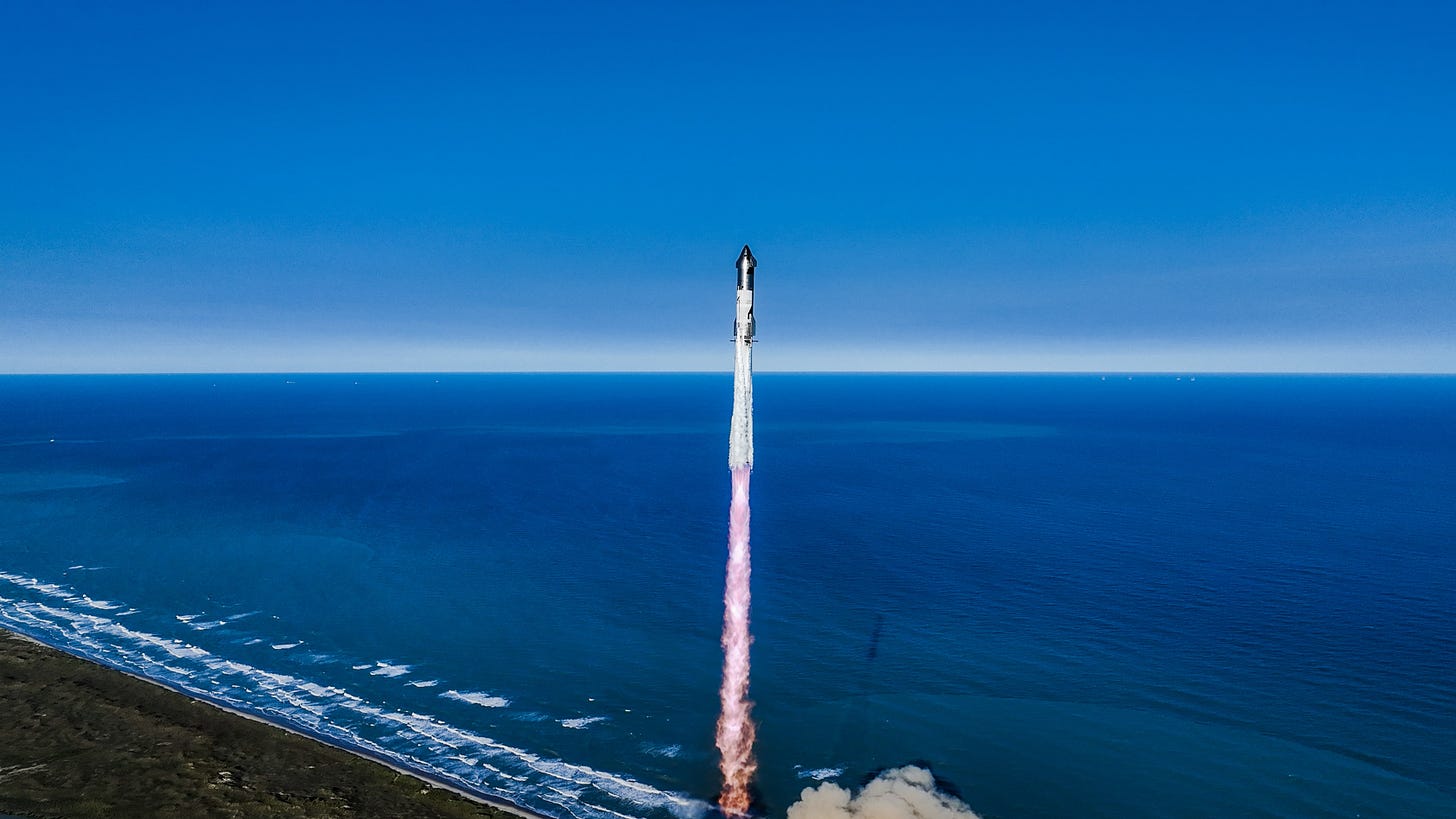SpaceX definitely accelerated their Starship program with only 37 days since flight 5 in October, compared to 129 days to flight 4 in June! Notably this was the swansong for Starship version 1, as they will transition to Starship version 2 for the next launch. To prepare for this transition SpaceX tested some new capabilities and stressed the Flight 6 vehicle to the limit, to find out where it fails and upgrades needed.
“The objectives for Starship Flight 6 are: -
1. Restart of Raptor engines in vacuum.
2. Daylight landing of the ship [to gather more visual data].
3. Higher peak heating (steeper) reentry.
4. Faster/harder booster catch.
There are thousands of small design changes also being tested.” ~ Elon Musk/X
Starship needs to descend from orbit at a precise time and location to return to the launch site, so on Flight 6 they relit a single Raptor in space, to prove precise reentry is possible. The ship passed its trial by fire from the steeper reentry angle, despite having 2,100 heat protection tiles removed (to save weight and make room for landing lugs). After going sub-sonic, the ship lowered to horizontal, allowing it to fly more like a conventional aircraft, to test its cross-range capability. Considering how gently it landed at the designated spot in the Indian Ocean, this proves Starship can accurately return to the launch site, similar to the Starship booster. Unfortunately the Flight 6 booster had to perform a water landing off the coast of Starbase due to a communications issue, although realistically it was an engineering miracle they managed to catch the booster on Flight 5.
“Lost comms to the launch tower computer. Catch would probably still have worked, but we weren't sure, so erred on the side of caution.” ~ Elon Musk/X
However, this apparent failure should be celebrated because it shows safety is the top priority at SpaceX, over-riding their desire to test everything to destruction – and impress their VIP audience.
“General Chance Saltzman, the U.S. Space Force’s chief of space operations watched the Starship launch alongside SpaceX founder Elon Musk, President-elect Donald Trump and a number of lawmakers.” ~ Spacenews.com
Way ahead
SpaceX has everything in place to achieve the holy grail of rocketry, full and rapid reuse of the whole launch vehicle. Now they have proved booster catches are possible, catching the ship portion seems more than attainable. Starship 2 is designed to be even more durable to the stresses of reentry, which should allow finer control during the most critical phase of the flight, i.e. final approach. This will occur over North Mexico and South Texas, so they need to demonstrate Starship 2 can maintain adequate control during this glide phase, before FAA grant approval.
“Successful ocean landing of Starship! We will do one more ocean landing of the ship [on Flight 7]. If that goes well, then SpaceX will attempt to catch the ship with the tower.” ~ Elon Musk/X
The company’s relations with the FAA has been colorful, with the regulator causing unnecessary delays to the permitting process. Hopefully this problem is behind them now, as the FAA are taking steps to reform the launch licensing process, no doubt ‘encouraged’ by Elon’s next big project, the Department of Government Efficiency (DOGE)… Interestingly Flight 6 had a plush banana as the official payload, because Starship needed to send something to space to gain FAA approval for commercial applications. Now it has passed the banana test, SpaceX should use flight 7 to send Gen 2 Starlink satellites to orbit, to lower latency and 10X the bandwidth for users.

This successful flight indicates SpaceX are still on track to launch a Human Landing System (HLS) Starship to the moon, for NASA’s Artemis program. In addition, SpaceX plan to perform Mars missions in parallel, using the same launch infrastructure and orbital refueling depot developed for Artemis.
“I am highly confident that we can send several uncrewed Starships to Mars in 2 years. If those ships don’t increment the crater count on Mars, then crewed ships can be sent in 4 years.” ~ Elon Musk/X
Reported the uncrewed ships will carry Cybertrucks and Optimus robots, which can be used to prepare landing sites and facilities on Mars for the follow-up crew missions.
As previously mentioned USSF General Saltzman attended the Flight 6 launch, and hopefully he was suitably impressed. Starship offers a peerless capability for Space Force, something difficult to ignore for many good and pressing strategic reasons. No doubt Space Force will come into its own over the next few years, thanks to presidential support, so Starship has arrived at an opportune moment. Currently the USSF plan to use Starship for Rocket Cargo Transport although this could act as a springboard to far greater things, such as crewed Space Force missions. Cislunar space will become increasingly contested due to competing commercial and national interests, which suggests Starship will be pressed into service as a space patrol vehicle. How far the USSF want to go with Starship is debatable, geostationary space should be their first stop, followed by the moon, due to its strategic and political importance. However, Mars should be beyond their beat, leaving its governance and security down to SpaceX. While China intends to build a Starship clone in 2040/50, SpaceX plan to have a city on Mars by then, making Chinese new arrivals seem like tourists.
In conclusion
Flight 6 rounded out the last batch of tests for Starship before they commence orbital missions with Starship 2. The next flight could occur before Christmas, given SpaceX’s accelerated launch cadence and the FAA’s more affirmative attitude.
“In a draft version of what is known as an "Environmental Assessment," the FAA indicated that it will grant SpaceX permission to increase the number of Starship launches in South Texas to 25 per year from the current limit of five. Additionally, the company will likely be allowed to continue increasing the size and power of the Super Heavy booster stage and Starship upper stage.” ~ Ars Technica
Next year SpaceX will perform a propellant transfer test between Starships, which potentially opens the entire inner solar system to exploration. Great time to be alive and a huge step for humanity if we manage to base on the moon and Mars!





What happens when SpaceX refuses USSF rides to Mars?